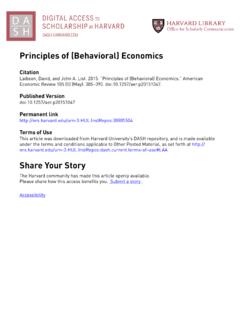Transcription of Government Control of the Media - wallis.rochester.edu
1 Government Control of the Media Scott Gehlbach and Konstantin Sonin . September 2008. Abstract We present a formal model of Government Control of the Media to illuminate variation in Media freedom across countries and over time, with particular application to less democratic states. The extent of Media freedom depends critically on two variables: the mobilizing character of the Government and the size of the advertising market. Media bias is greater and state ownership of the Media more likely when the need for social mobilization is large; however, the distinction between state and private Media is smaller.
2 Large advertising markets reduce Media bias in both state and private Media , but increase the incentive for the Government to nationalize private Media . We illustrate these arguments with a case study of Media freedom in postcommunist Russia, where Media bias has responded to the mobilizing needs of the Kremlin and Government Control over the Media has grown in tandem with the size of the advertising market.. Gehlbach: University of Wisconsin Madison and CEFIR, Sonin: New Eco- nomic School, CEFIR, and CEPR, 1 Introduction A substantial literature ties Media freedom to good Less is known about the determinants of Media freedom itself.
3 Although correlated with the presence of democratic institutions, political institutions alone do not determine Media freedom. As Figure 1 illus- trates, many nondemocracies have higher levels of Media freedom than many democracies, and among the least democratic countries there is little obvious relationship between political institutions and Media Moreover, Media freedom often fluctuates within countries even as political institutions remain unchanged. What accounts for variation in Media freedom across space and time?
4 In this paper, we provide a formal framework to explore this question. We focus especially on less democratic states where the Government uses the Media to mobilize citizens in support of actions that may not be in their individual best interest, though some of our arguments may also apply to democracies. We emphasize variation along two dimensions of Media freedom: Media ownership, by which we generally mean whether the Media are state-owned or private, and Media bias, which we define as the extent to which the Media misreport the news in favor of Government interests.
5 As we show, Media ownership typically influences Media bias, but Media ownership itself is endogenous to the anticipated bias under state and private ownership. Our theoretical framework stresses a fundamental constraint facing any Government seek- ing to influence Media content: bias in reporting reduces the informational content of the news, thus lowering the likelihood that individuals who need that information to make deci- sions will read, watch, or listen to it. This constraint operates in two ways.
6 First, excessive Media bias works against the Government 's desire for social mobilization, as citizens who ignore the news cannot be influenced by it. Second, Media bias reduces advertising revenue, as Media consumption is less when pro- Government bias is large. In general, this reduc- tion in advertising revenue is costly to the Government , regardless of whether the Media are state owned (to the extent that profits and losses of state-owned companies are internalized). or private (because the Government must subsidize private owners to compensate for lost revenue).
7 We highlight two variables that influence the operation of this constraint. First, the mobilizing character of the Government determines the value the Government places on the mobilization of citizens to take actions that are not necessarily in their individual best interest, such as voting and demonstrating in favor of the incumbent regime (Magaloni, 2006;. Simpser, 2007) or exposing the corruption of local bureaucrats (Lorentzen, 2006). When the need for social mobilization is large, the Government is more willing to pay the cost (foregone advertising revenue or subsidies) of Media bias.
8 Media bias may therefore be greater in autocratic states whose leaders aim to transform society, or under populist governments that retain power through mass public participation, than in kleptocracies or sultanistic . Moreover, holding regime type constant, Media bias will be greater in periods 1. Much recent work on the topic is in the political economy literature. Representative papers include Besley and Burgess (2002); Adsera , Boix, and Payne (2003); Brunetti and Weder (2003); Reinikka and Svensson (2005); Besley and Prat (2006); Prat and Stro mberg (2006); and Treisman (2007).
9 2. Obviously, causality cannot be inferred from the simple bivariate relationship depicted in Figure 1. 3. This argument has parallels in Wintrobe's (1990) suggestion that repression will be greater under total- 1. 100. NOR. NZL. TMP CHE. BEL. DNK. SWE. AUS. JAM FIN. USA. NLD. DEU. FREE CAN. PRT. AUT. CRI. IRL. ESP. 80. SLB. EST CYP. JPN. GBR. LTU. POLCZE. LVABOL. FRA MUS. GUY CHL SVN. MLI KOR BWA ZAFTTO. PNG. URY. HUN. IGRC. ISRTA. BEN. NAM DOM PAN. BRA. SVK MNG. ARG. Media Freedom MDGBGR. PHL THA.
10 BFA SEN. 60. UGA COM ECU. SLV. MKD NIC IND. PARTLY FREE VEN. ROM. MWIFJIMEX. MOZ HND. TZA HRV GHA PER LSOPRY. KWT. MAR GAB GNB LKA UKRGTM. JOR ALB MDA. PAK ARM GEO. NER RUSBGD COL. 40. COG BIH. IDN NPL. QAT GMB KGZDJI KHM ZMB TUR. KEN ETH. SGPYUG. YEM. NGA HTI MYSCAF. BHR MRT KAZ. OMNBTN. LAOAZE. ZWE CIV GIN SOM. EGY CMRTUNTCD. AGO. TGO SLE. LBR. SWZSYR ERI. ARE VNM RWA. IRN. 20. SAU UZB GNQBLRDZA NOT FREE. CHN BDI. SDN ZAR. TKM AFG TJK. LBY. IRQ CUB. PRK MMR. 0. 10 5 0 5 10. Democracy Figure 1: Media freedom and democracy.

